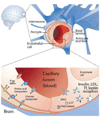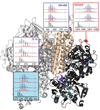Emerging mass spectrometry-based approaches to probe protein-receptor interactions: focus on overcoming physiological barriers
- PMID: 23624418
- PMCID: PMC3737317
- DOI: 10.1016/j.addr.2013.04.014
Emerging mass spectrometry-based approaches to probe protein-receptor interactions: focus on overcoming physiological barriers
Abstract
Physiological barriers, such as the blood-brain barrier and intestinal epithelial barrier, remain significant obstacles towards wider utilization of biopharmaceutical products. Receptor-mediated transcytosis has long been viewed as an attractive means of crossing such barriers, but successful exploitation of this route requires better understanding of the interactions between the receptors and protein-based therapeutics. Detailed characterization of such processes at the molecular level is challenging due to the very large physical size and heterogeneity of these species, which makes use of many state-of-the art analytical techniques, such as high-resolution NMR and X-ray crystallography impractical. Mass spectrometry has emerged in the past decade as a powerful tool to study protein-receptor interactions, although its applications to investigate interaction of biopharmaceuticals with their physiological partners are still limited. We highlight the potential of this technique by considering several recent examples where it had been instrumental for understanding molecular mechanisms critical for receptor-mediated transcytosis of transferrin-based therapeutics.
Keywords: BBB; Blood–brain barrier; CNS; CSF; ESI; Fusion proteins; GHT; Growth hormone; HDX; Intestinal epithelial barrier; Lysozyme; Lz; LzT; MS; Protein aggregation; Protein therapeutics; Protein–drug conjugate; Receptor-mediated transcytosis; Tf; TfR; Transferrin; Transferrin receptor; central nervous system; cerebrospinal fluid; electrospray ionization; growth hormone-transferrin fusion protein; hydrogen/deuterium exchange; lysozyme; lysozyme–transferrin conjugate; mass spectrometry; transferrin; transferrin receptor.
Copyright © 2013 Elsevier B.V. All rights reserved.
Figures






Similar articles
-
Mass spectrometry-guided optimization and characterization of a biologically active transferrin-lysozyme model drug conjugate.Mol Pharm. 2013 May 6;10(5):1998-2007. doi: 10.1021/mp400026y. Epub 2013 Apr 10. Mol Pharm. 2013. PMID: 23534953 Free PMC article.
-
Mass spectrometry study of a transferrin-based protein drug reveals the key role of protein aggregation for successful oral delivery.Proc Natl Acad Sci U S A. 2012 Aug 21;109(34):13544-8. doi: 10.1073/pnas.1206924109. Epub 2012 Aug 6. Proc Natl Acad Sci U S A. 2012. PMID: 22869744 Free PMC article.
-
Transcytosis of protein through the mammalian cerebral epithelium and endothelium. III. Receptor-mediated transcytosis through the blood-brain barrier of blood-borne transferrin and antibody against the transferrin receptor.Exp Neurol. 1996 Nov;142(1):47-65. doi: 10.1006/exnr.1996.0178. Exp Neurol. 1996. PMID: 8912898
-
Brain iron homeostasis.Dan Med Bull. 2002 Nov;49(4):279-301. Dan Med Bull. 2002. PMID: 12553165 Review.
-
Transferrin receptors-targeting nanocarriers for efficient targeted delivery and transcytosis of drugs into the brain tumors: a review of recent advancements and emerging trends.Drug Deliv Transl Res. 2018 Oct;8(5):1545-1563. doi: 10.1007/s13346-018-0552-2. Drug Deliv Transl Res. 2018. PMID: 29916012 Review.
Cited by
-
A new liquid chromatography-mass spectrometry-based method to quantitate exogenous recombinant transferrin in cerebrospinal fluid: a potential approach for pharmacokinetic studies of transferrin-based therapeutics in the central nervous systems.Eur J Mass Spectrom (Chichester). 2015;21(3):369-76. doi: 10.1255/ejms.1365. Eur J Mass Spectrom (Chichester). 2015. PMID: 26307718 Free PMC article.
-
A new approach to measuring protein backbone protection with high spatial resolution using H/D exchange and electron capture dissociation.Anal Chem. 2013 Oct 1;85(19):9173-80. doi: 10.1021/ac401868b. Epub 2013 Sep 12. Anal Chem. 2013. PMID: 23978257 Free PMC article.
-
Evaluation of Nonferrous Metals as Potential In Vivo Tracers of Transferrin-Based Therapeutics.J Am Soc Mass Spectrom. 2016 Feb;27(2):211-9. doi: 10.1007/s13361-015-1267-y. Epub 2015 Sep 21. J Am Soc Mass Spectrom. 2016. PMID: 26392277 Free PMC article.
-
High Resolution Mapping of Bactericidal Monoclonal Antibody Binding Epitopes on Staphylococcus aureus Antigen MntC.PLoS Pathog. 2016 Sep 30;12(9):e1005908. doi: 10.1371/journal.ppat.1005908. eCollection 2016 Sep. PLoS Pathog. 2016. PMID: 27689696 Free PMC article.
-
Enhancing the quality of H/D exchange measurements with mass spectrometry detection in disulfide-rich proteins using electron capture dissociation.Anal Chem. 2014 Jun 3;86(11):5225-31. doi: 10.1021/ac500904p. Epub 2014 May 22. Anal Chem. 2014. PMID: 24820935 Free PMC article.
References
-
- Knäblein J, editor. Modern Biopharmaceuticals: Design, Development and Optimization. Vol. 1-4. Weinheim: WILEY-VCH Verlag GmbH & Co; 2005.
-
- Walsh G. Pharmaceutical biotechnology : concepts and applications. Chichester, England ; Hoboken, NJ: John Wiley & Sons; 2007.
-
- Leader B, Baca QJ, Golan DE. Protein therapeutics: a summary and pharmacological classification. Nat. Rev. Drug Discov. 2008;7:21–39. - PubMed
-
- Deeken JF, Loscher W. The blood-brain barrier and cancer: transporters, treatment, and Trojan horses. Clin. Cancer Res. 2007;13:1663–1674. - PubMed
Publication types
MeSH terms
Substances
Grants and funding
LinkOut - more resources
Full Text Sources
Other Literature Sources
Miscellaneous

